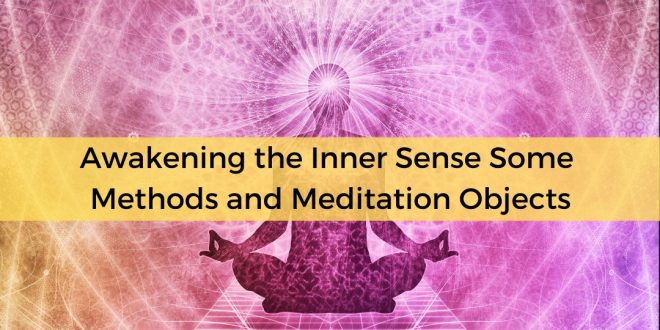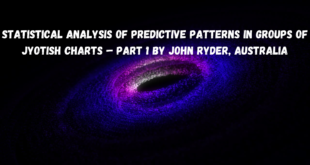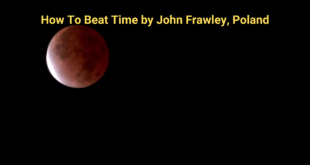Related Articles
Awakening the Inner Sense – Some Methods &
Meditation Objects
What we know as our weekday is a tide of miscellaneous information which we receive with our five senses and put together to an integral picture in the brain. The sense organs are the gates of our body – they connect the outside world with the inner world and determine, dependent on our state of consciousness, how we experience this world.
But is there more to human sense activity than touching, seeing, hearing, smelling and tasting? There is, according to many cultures and religions where we find the notion of an inner sense. This sense is thought of as a mode of perception which directly and intuitively gives insight to the essence or true nature of the object perceived. Often this subtle or inner sense is linked to the eye as a widespread symbol of light, cognition and truth. It is then addressed as the “inner eye”, “third eye” or “eye of the heart”, common among mystics who experienced the divine light. In Indian mythology, for example, this inner sense is expressed as God Shiva’s frontal eye that gives him unifying vision. Accordingly, tantric yogis try to open this third eye by activating the “Ajna Chakra”, located between the eyebrows. Likewise,
the Buddha Siddhartha Gautama received enlightenment through a “celestial eye” (prajnacaksus) which permitted him to understand the forces of existence and their manifestation in the chain of causality. The Greek philosophers spoke of an “Eye of the Spirit” which has to be opened and purified to see the truth. While the Old Testament calls the prophets “seers” and refers to an all-seeing eye or “Eye of Providence” that turns to those who fear God and gives them superior insights or strength, the New Testament takes up the Greek philosopher’s notion of the “Eye of the Soul or Heart”: the eye becomes the object of purity (Matthew, 6.22), and the Eye of the Heart has to be opened in order to see God (Acts 9.18). Over the centuries, Desert Fathers, Gnostics, and Mystics alike further reported experiences of the inner sense as inner eye or eye of the heart or soul. Since the early modern period, Western esoterics and scientists interested in unifying the scientific and spiritual traditions are trying to find a physiological correspondence of this inner sense. In recent years, for example, the inner sense was associated with the pineal gland, based on scientific insights about the light sensitivity of this gland.

Meditation for the development of the inner sense
Developing our inner sense, therefore, is a way to improve our spiritual life. In fact, many of us are doing this already, more or less consciously. For example, while meditating, many have come to experience subjective visual appearances, ecstatic feelings or intuitive insights – first aspects of an inner sense waking up. But if we want to develop that inner sense to its full bloom, years and decades of constant exercise are necessary. In any case, awakening the
inner sense means choosing a meditation method which works directly with the inner sense or with its objects and function. Generally, meditation can be carried out on material objects which stimulate the inner sense; or on subtle objects which can be conceived of as objects of this inner sense.
Material meditation objects
Material meditation objects are perceived through the eyes, not through the inner sense, but concentrating on them can stimulate the inner sense and lead to subtle appearances. Meditation on material objects should support the inner sense or third eye in its function to mediate between the two brains or consciousness hemispheres. It should make aware to us our right intuitive emotional side as well as our left analytical rational side, bringing them into harmony with each other. This turns out best by means of squinting techniques which have been developed likewise in Western and Eastern traditions. Two different types of squinting must be distinguished here, though: the letting go of the eyes (parallel viewing) in which the concentration point shifts behind the object looked at, and the concentrative directing inside the eyes (cross viewing) in which the concentration point is drawn in front of the object looked at, in the direction of the observer. To distinguish these two types, we call the second type “doubling”. Doubling is the type of squinting ideal for meditation.
The simplest exercise of doubling is looking at the root of the nose, according to the way of Indian yogis. However, doubling can also be applied to distant material objects. Anthropologist and author Carlos Castaneda, for example, mentions a seeing technology called “gazing” which at first means to focus the view on an object, similar to the yogi’s cleaning exercise “trataka”. Sometimes, though, it is combined with squinting in which the practitioner moves apart the two pictures and thus superimposes two equally formed objects. The concentration on this superimposed object synchronizes the two consciousness hemispheres and, regularly practiced, produces a depth perception which carries the practitioner into other spheres of consciousness.
Another example of this form of meditation is the meditation on the “Tables of Chartres”. The tables are three legendary geometric figures of equal surface area, made from red and blue colored metal pieces shaped as rectangle, square, and circle. They are put down before oneself in two rows of alternating color and shape and doubled until a superimposed third table group appears in the middle. The knowledge around this old meditation type was maintained and passed on by gypsies and published by the French author Pierre Derlon for the first time.
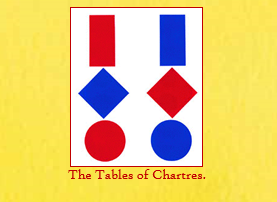
The subtle objects: Subjective visual phenomena
Subtle meditation objects can be feelings and thoughts. For developing the inner sense, however, those objects are particularly well suited which appear through the fusion of the inner sense and the visual sense. I’m referring to those subjective visual phenomena which are known in ophthalmology as “entoptic phenomena”. Entoptics are phenomena which are believed by the observer to be seen outside of him- or herself, though, physiologically explained; they are generated by the observer’s visual system. The following entoptic phenomena are suited as meditation objects for most people:
Afterimages: contrasting colored afterimages may be explained as the continuation of the effect of a visual stimulus when this stimulus has gone already. For example, blinking into the sun for a short time period will produce the colored afterimage of the sun in our visual field.
Meditation on afterimages includes producing these images by shortly glancing into a light source, e.g. a bulb or a candle flame. Against a dark background or with the eyes shut, we observe these colored luminous spots until they lose their intensity. Again, we generate another afterimage and observe it until it fades and so on. Observing the afterimage, we actively move it with our view and watch it change its form and intensity; we study its proper motion and the influence of our eye movements on its luminosity.
Phosphenes: Phosphenes are colored spots and blurs in the dark, often seen with eyes closed. They are said to be discharges of visual neurons. Meditation on phosphenes works similar like meditation on afterimages. However, it is more difficult because it has to be done without the stimulating effect of an external light source. We close the eyes and watch the colored spots taking shape in the dark. They tend to disappear from our awareness and therefore have to be made aware again and again by realigning our attention. An elaborated system of consciousness development focusing on afterimages and phosphenes was created by the French scientist and inventor, Dr. Francis Lefebure; the exercises of his “Phosphenism” combine visual concentration on afterimages with (neuro) physiological rhythmics.
Eye Floaters (mouches volantes): Eye floaters are scattered semi-transparent dots and strands appearing with bright light conditions in our visual fields and following the eyes’ motions. In ophthalmology, they are regarded as a normal opacity of the vitreous due to progressing age. Eye floaters meditation means that we bring these the objects into our field of vision and consciously look at them. We explore them, get to know their forms, constellations, and movements. We notice that the floaters constantly drift away, mainly down, and try to keep them in the field of vision. More advanced meditators of eye floaters will begin to see changes in movement, size and luminosity. The teaching of my mentor, seer Nestor, provides elaborated seeing and ecstasy techniques to work with eye floaters, as well as a spiritual interpretation of these dots and strands.
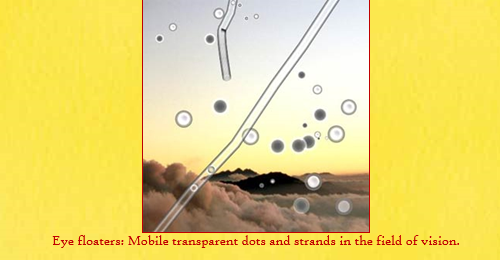
Blue field entoptic phenomenon: this formal term refers to “flying corpuscles” or “luminous spots”, tiny luminous spheres moving fast along in wound tracks. It is best seen in the blue sky (therefore: blue field entoptic phenomenon), but can become very strong in situations with extreme physical challenges like shocks or blackouts. From a medical point of view, it’s related to white blood cells flowing in the capillaries of the retina.
Unlike the other entoptics, the luminous spots can’t be fixed with the eyes directly but are seen in the peripheral field of vision. Observing luminous spots, therefore, improves our alertness in the whole visual field, rather than our ability to concentrate on particular objects.
Dr. Wilhelm Reich, the Austrian-American psychiatrist and founder of the orgon theory, explained the blue field entoptic phenomenon as a kind of orgon radiation. More spiritually oriented followers of Reich suggest to concentrate on these immaterial luminous spots, in order to silence the inner dialogue and find inner peace.
By consciously looking at entoptic phenomena like the above mentioned we withdraw our five senses from the material sense objects and channel the energy usually needed to maintain their functioning to the inner sense. This way, we awaken the inner sense, which in turn will help us recognize and feel immediately and with great intensity the higher significance of these dots, spots and strands as well as their relation to ourselves. We then intuitively understand why such entoptics were watched by people of all times, often provided with religious meanings and used as concentration objects.
Literature:
Bókkon, István: Phosphene phenomenon: A new concept, in: BioSystems 92 (2008): 168-174Chen, Spencer C. u.a.: Simulating prosthetic vision: I. Visual models of phosphenes, in: Vision Research, vol. 49, nr. 12, June 2009, p. 1493-1506
Castaneda, Carlos: Voyage to Ixtlan, 1972
Castaneda, Carlos: The Second Ring of Power, 1977
Derlon, Pierre: Die Gärten der Einweihung. Sphinx Verlag, Basel 1978
Lewis-Williams, J. D. / Dowson, T. A.: The Signs of All Times, in: Current Anthropology, vol. 29, nr. 2, April 1988
Meslin, Michel: Eye, in: Eliade, Mircea (Ed.): The Encyclopaedia of Religion (2nd ed.), 2005, p. 2.939-2.941
Pennington, George: Die Tafeln von Chartres. Die gnostische Schau des Westens, Patmos 2002
Sinclair, S.H., M. Azar-Cavanaugh, K.A. Soper, R.F. Tuma, and H.N. Mayrovitz. “Investigation of the source of the blue field entoptic phenomenon.” Investigative Ophthalmology and Visual Science, 4 (1989): 668-673.
Tausin, Floco: Mouches Volantes. Eye Floaters as Shining Structure of Consciousness, Bern: Leuchtstruktur Verlag 2009
Tausin, Floco: Kokons und Fasern – Leuchtkugeln und Leuchtfäden. Mouches volantes als Inspirationsquelle für Carlos Castaneda?, in : AHA Magazin 5/2006
Trick, Gary L.; Kronenberg, Alaina: Entoptic Imagery and Afterimages, in: Tasman, William; Jaeger, Edward A. (Ed.): Duane’s Ophthalmology, Philadelphia: Lippincott Williams & Wilkins 2007 [electronic edition]
Learn Astrology: Join Our Upcoming Astrology Classes – Click Here
Learn Astrology: Join Our Recorded Astrology Classes – Click Here
 Saptarishis Astrology Magazine Into Creating Astrologers
Saptarishis Astrology Magazine Into Creating Astrologers

